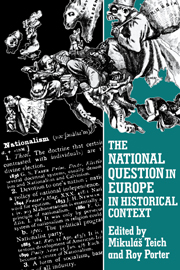Book contents
- Frontmatter
- Contents
- List of maps
- Notes on contributors
- Acknowledgements
- Introduction
- 1 The British Isles: Celt and Saxon
- 2 The making of the French nation
- 3 The national question in Italy
- 4 The roots of the national question in Spain
- 5 Shifting nationalism: Belgians, Flemings and Walloons
- 6 The nation in German history
- 7 Nationalism and nation-state in Germany
- 8 The national identity of the Austrians
- 9 The Czechs
- 10 The national question in Hungary
- 11 The union of Dalmatia with northern Croatia: a crucial question of the Croatian national integration in the nineteenth century
- 12 The national question in Poland in the twentieth century
- 13 Finland: from Napoleonic legacy to Nordic co-operation
- Index
11 - The union of Dalmatia with northern Croatia: a crucial question of the Croatian national integration in the nineteenth century
Published online by Cambridge University Press: 30 November 2009
- Frontmatter
- Contents
- List of maps
- Notes on contributors
- Acknowledgements
- Introduction
- 1 The British Isles: Celt and Saxon
- 2 The making of the French nation
- 3 The national question in Italy
- 4 The roots of the national question in Spain
- 5 Shifting nationalism: Belgians, Flemings and Walloons
- 6 The nation in German history
- 7 Nationalism and nation-state in Germany
- 8 The national identity of the Austrians
- 9 The Czechs
- 10 The national question in Hungary
- 11 The union of Dalmatia with northern Croatia: a crucial question of the Croatian national integration in the nineteenth century
- 12 The national question in Poland in the twentieth century
- 13 Finland: from Napoleonic legacy to Nordic co-operation
- Index
Summary
THE TERRITORIES INVOLVED IN THE INTEGRATION OF THE CROATIAN NATION
When the republics of Venice and Dubrovnik ceased to exist and the Napoleonic era came to an end, most of the territory where the unification of the Croatian nation was to take place belonged to the Habsburg Monarchy. Northern civilian Croatia and Slavonia had traditionally enjoyed autonomy within the crown of Hungary, but this virtually came to an end with the Magyar constitutional laws of 1848. These changes therefore provoked opposition to Magyar domination from the Croatian national movement, and resulted in a revolt led by the Ban (traditional governor) Jelačić with soldiers from the Military Frontier.
The nobility, who comprised the populus politicus of Croatia and Slavonia, had based their arguments for autonomy on historical claims deriving from the medieval kingdom of Croatia centred on Dalmatia. Their theorists believed that their predecessors had recognized the Hungarian king in the twelfth century by a treaty, and thus preserved the continuity of the Triune Kingdom, that is, the kingdoms of Dalmatia, Croatia and Slavonia. The Magyar interpretation, on the other hand, considered Croatian territory as acquired by conquest, partes subiugatae or adnexae, and thus entitled to no modern autonomy based on historic rights.
- Type
- Chapter
- Information
- The National Question in Europe in Historical Context , pp. 270 - 292Publisher: Cambridge University PressPrint publication year: 1993
- 1
- Cited by

